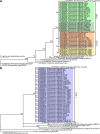An 18S rRNA Workflow for Characterizing Protists in Sewage, with a Focus on Zoonotic Trichomonads
- PMID: 28540488
- PMCID: PMC5653731
- DOI: 10.1007/s00248-017-0996-9
An 18S rRNA Workflow for Characterizing Protists in Sewage, with a Focus on Zoonotic Trichomonads
Abstract
Microbial eukaryotes (protists) are important components of terrestrial and aquatic environments, as well as animal and human microbiomes. Their relationships with metazoa range from mutualistic to parasitic and zoonotic (i.e., transmissible between humans and animals). Despite their ecological importance, our knowledge of protists in urban environments lags behind that of bacteria, largely due to a lack of experimentally validated high-throughput protocols that produce accurate estimates of protist diversity while minimizing non-protist DNA representation. We optimized protocols for detecting zoonotic protists in raw sewage samples, with a focus on trichomonad taxa. First, we investigated the utility of two commonly used variable regions of the 18S rRNA marker gene, V4 and V9, by amplifying and Sanger sequencing 23 different eukaryotic species, including 16 protist species such as Cryptosporidium parvum, Giardia intestinalis, Toxoplasma gondii, and species of trichomonad. Next, we optimized wet-lab methods for sample processing and Illumina sequencing of both regions from raw sewage collected from a private apartment building in New York City. Our results show that both regions are effective at identifying several zoonotic protists that may be present in sewage. A combination of small extractions (1 mL volumes) performed on the same day as sample collection, and the incorporation of a vertebrate blocking primer, is ideal to detect protist taxa of interest and combat the effects of metazoan DNA. We expect that the robust, standardized methods presented in our workflow will be applicable to investigations of protists in other environmental samples, and will help facilitate large-scale investigations of protistan diversity.
Keywords: 18S rRNA amplicon sequencing; Environmental sequencing; Protist; Sewage; Trichomonad; Zoonoses.
Conflict of interest statement
Conflict of Interest
The authors declare that they have no conflict of interest.
Ethics Approval
This study does not contain any studies with human participants performed by any of the authors. All procedures performed in studies involving animals were in accordance with the ethical standards of the institution or practice at which the studies were conducted. Bird sampling procedures were approved under the U.S. Fish and Wildlife Service Scientific Collecting Permit (MB03368B) issued to the Wildlife Investigations Laboratory, California Department of Fish and Wildlife.
Figures





Similar articles
-
Patterns of protist diversity associated with raw sewage in New York City.ISME J. 2019 Nov;13(11):2750-2763. doi: 10.1038/s41396-019-0467-z. Epub 2019 Jul 9. ISME J. 2019. PMID: 31289345 Free PMC article.
-
Measurements of soil protist richness and community composition are influenced by primer pair, annealing temperature, and bioinformatics choices.Appl Environ Microbiol. 2024 Jul 24;90(7):e0080024. doi: 10.1128/aem.00800-24. Epub 2024 Jun 26. Appl Environ Microbiol. 2024. PMID: 38920364 Free PMC article.
-
Surveillance of Giardia and Cryptosporidium in sewage from an urban area in Brazil.Rev Bras Parasitol Vet. 2019 Jun 6;28(2):291-297. doi: 10.1590/S1984-29612019037. Rev Bras Parasitol Vet. 2019. PMID: 31188950
-
Is real-time PCR-based diagnosis similar in performance to routine parasitological examination for the identification of Giardia intestinalis, Cryptosporidium parvum/Cryptosporidium hominis and Entamoeba histolytica from stool samples? Evaluation of a new commercial multiplex PCR assay and literature review.Clin Microbiol Infect. 2016 Feb;22(2):190.e1-190.e8. doi: 10.1016/j.cmi.2015.10.019. Epub 2015 Nov 6. Clin Microbiol Infect. 2016. PMID: 26548509 Review.
-
Exploring the environmental diversity of kinetoplastid flagellates in the high-throughput DNA sequencing era.Mem Inst Oswaldo Cruz. 2015 Dec;110(8):956-65. doi: 10.1590/0074-02760150253. Epub 2015 Nov 24. Mem Inst Oswaldo Cruz. 2015. PMID: 26602872 Free PMC article. Review.
Cited by
-
Protistan and fungal diversity in soils and freshwater lakes are substantially different.Sci Rep. 2020 Nov 18;10(1):20025. doi: 10.1038/s41598-020-77045-7. Sci Rep. 2020. PMID: 33208814 Free PMC article.
-
Entamoeba gingivalis is associated with periodontal conditions in Chinese young patients: A cross-sectional study.Front Cell Infect Microbiol. 2022 Oct 7;12:1020730. doi: 10.3389/fcimb.2022.1020730. eCollection 2022. Front Cell Infect Microbiol. 2022. PMID: 36275028 Free PMC article.
-
The eukaryome of African children is influenced by geographic location, gut biogeography, and nutritional status.Microlife. 2023 Jul 20;4:uqad033. doi: 10.1093/femsml/uqad033. eCollection 2023. Microlife. 2023. PMID: 37680753 Free PMC article.
-
Diagnostic Methods of Common Intestinal Protozoa: Current and Future Immunological and Molecular Methods.Trop Med Infect Dis. 2022 Sep 21;7(10):253. doi: 10.3390/tropicalmed7100253. Trop Med Infect Dis. 2022. PMID: 36287994 Free PMC article. Review.
-
Longitudinal Comparison of Bacterial Diversity and Antibiotic Resistance Genes in New York City Sewage.mSystems. 2019 Aug 6;4(4):e00327-19. doi: 10.1128/mSystems.00327-19. mSystems. 2019. PMID: 31387933 Free PMC article.
References
-
- Sunagawa S, Coelho LP, Chaffron S, Kultima JR, Labadie K, Salazar G, Djahanschiri B, Zeller G, Mende DR, Alberti A, Cornejo-Castillo FM, Costea PI, Cruaud C, d'Ovidio F, Engelen S, Ferrera I, Gasol JM, Guidi L, Hildebrand F, Kokoszka F, Lepoivre C, Lima-Mendez G, Poulain J, Poulos BT, Royo-Llonch M, Sarmento H, Vieira-Silva S, Dimier C, Picheral M, Searson S, Kandels-Lewis S, Tara Oceans c. Bowler C, de Vargas C, Gorsky G, Grimsley N, Hingamp P, Iudicone D, Jaillon O, Not F, Ogata H, Pesant S, Speich S, Stemmann L, Sullivan MB, Weissenbach J, Wincker P, Karsenti E, Raes J, Acinas SG, Bork P. Ocean plankton. Structure and function of the global ocean microbiome. Science. 2015;348(6237):1261359. doi: 10.1126/science.1261359. - DOI - PubMed
Publication types
MeSH terms
Substances
LinkOut - more resources
Full Text Sources
Other Literature Sources
Molecular Biology Databases
Miscellaneous

